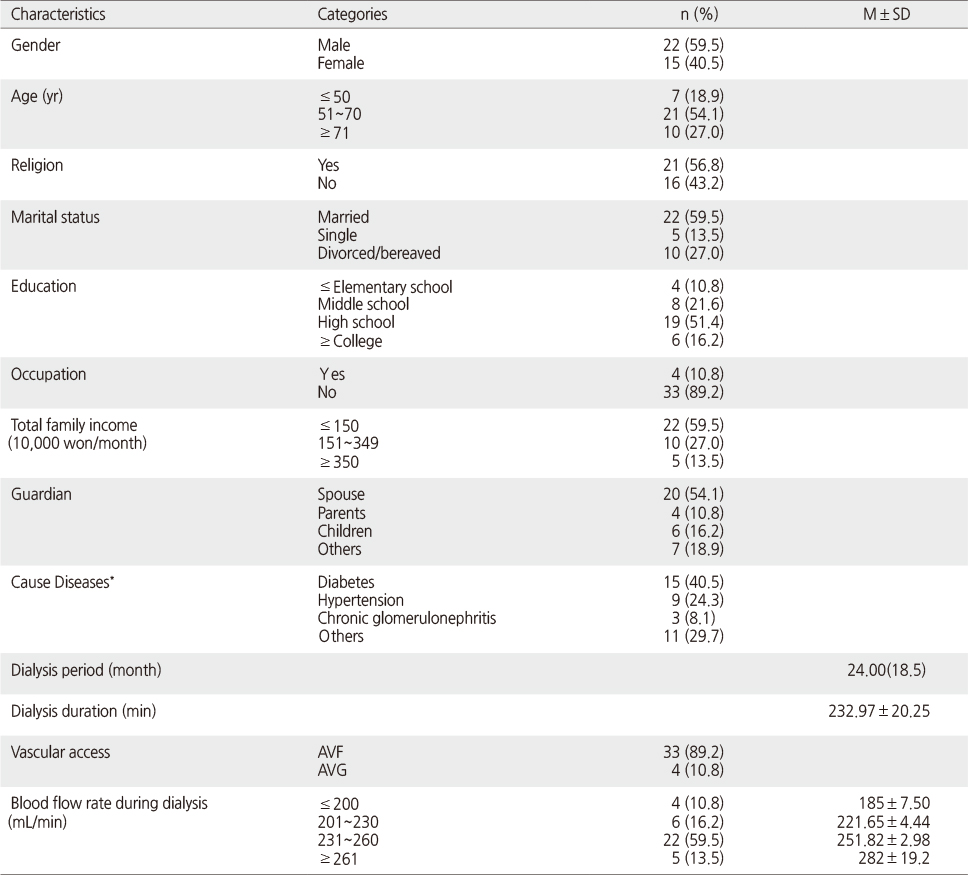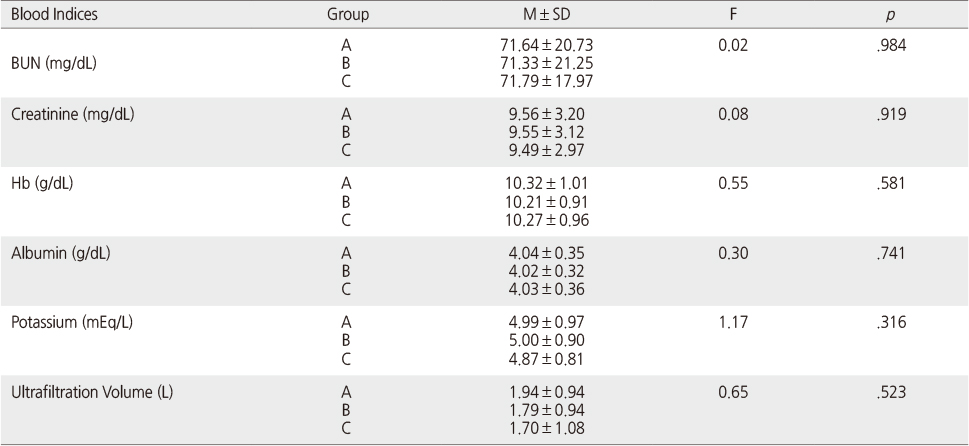Articles
- Page Path
- HOME > J Korean Acad Nurs > Volume 46(5); 2016 > Article
-
Original Article
- The Effect of Dialysate Flow Rate on Dialysis Adequacy and Fatigue in Hemodialysis Patients
- Sun Mi Cha, Hye Sook Min
-
Journal of Korean Academy of Nursing 2016;46(5):642-652.
DOI: https://doi.org/10.4040/jkan.2016.46.5.642
Published online: October 31, 2016
1Artificial Kidney Unit, Bethesda Hospital, Yangsan, Korea.
2Department of Nursing, Dong-A University, Busan, Korea.
- Address reprint requests to: Min, Hye Sook. Department of Nursing, Dong-A University, 32 Daesin Gongwon-ro, Seo-gu, Busan 49201, Korea. Tel: +82-51-240-2872, Fax: +82-51-240-2872, hsmin@dau.ac.kr
© 2016 Korean Society of Nursing Science
This is an Open Access article distributed under the terms of the Creative Commons Attribution NoDerivs License. (http://creativecommons.org/licenses/by-nd/4.0/) If the original work is properly cited and retained without any modification or reproduction, it can be used and re-distributed in any format and medium.
Abstract
-
Purpose
- In this single repeated measures study, an examination was done on the effects of dialysate flow rate on dialysis adequacy and fatigue in patients receiving hemodialysis.
-
Methods
- This study was a prospective single center study in which repeated measures analysis of variance were used to compare Kt/V urea (Kt/V) and urea reduction ratio (URR) as dialysis adequacy measures and level of fatigue at different dialysate flow rates: twice as fast as the participant’s own blood flow, 500 mL/min, and 700 mL/min. Thirty-seven hemodialysis patients received all three dialysate flow rates using counterbalancing.
-
Results
- The Kt/V (M±SD) was 1.40±0.25 at twice the blood flow rate, 1.41±0.23 at 500 mL/min, and 1.46±0.24 at 700 mL/min. The URR (M±SD) was 68.20±5.90 at twice the blood flow rate, 68.67±5.22 at 500 mL/min, and 70.11±5.13 at 700 mL/min. When dialysate flow rate was increased from twice the blood flow rate to 700 mL/min and from 500 mL/min to 700 mL/min, Kt/V and URR showed relative gains. There was no difference in fatigue according to dialysate flow rate.
-
Conclusion
- Increasing the dialysate flow rate to 700 mL/min is associated with a significant nicrease in dialysis adequacy. Hemodialysis with a dialysate flow rate of 700 mL/min should be considered in selected patients not achieving adequacy despite extended treatment times and optimized blood flow rate.
This manuscript is a condensed form of the first author’s master’s thesis from Dong-A University.
The authors declared no conflict of interest.
- 1. National Kidney Foundation. Clinical practice guidelines and clinical practice recommendations [Internet]. New York, NY, Author. 2006;cited 2013 October 25. Available from: http://www2.kidney.org/professionals/KDOQI/guideline_upHD_PD_VA
- 2. ESRD Registry Committee, Korean Society of Nephrology. Current renal replacement therapy in Korea: Insan memorial dialysis registry registry, 2014 [Internet]. Seoul, The Korean Society of Nephrology. 2014;cited 2015 May 28. Available from: http://www.ksn.or.kr/journal/2015/index.html
- 3. Curtin RB, Bultman DC, Thomas-Hawkins C, Walters BA, Schatell D. Hemodialysis patients’ symptom experiences: Effects on physical and mental functioning. Nephrol Nurs J. 2002;29(6):562. PubMed
- 4. Kyu HS. Adequacy of hemodialysis updated. Korean J Med. 2003;64(6):618–624.
- 5. Sehgal AR, Dor A, Tsai AC. Morbidity and cost implications of inadequate hemodialysis. Am J Kidney Dis. 2001;37(6):1223–1231. ArticlePubMed
- 6. Kim HR. Fatigue and its related factors in patients on hemodialysis. J Nurs Acad Soc. 1996;26(1):53–72.ArticlePDF
- 7. Choi EY. Prediction model of fatigue for hemodialysis patients [dissertation]. Seoul, Kyung Hee University. 2005;1–132.
- 8. Letchmi S, Das S, Halim H, Zakariah FA, Hassan H, Mat S, et al. Fatigue experienced by patients receiving maintenance dialysis in hemodialysis units. Nurs Health Sci. 2011;13(1):60–64. ArticlePubMed
- 9. Byeon YS, Gu JE. Correlates of fatigue with physiological factors in hemodialysis patients. J Korean Biol Nurs Sci. 2003;5(2):5–12.
- 10. Health Insurance Review and Assessment Service. 2010 Year of hemodialysis adequacy detailed plan guide [Internet]. Seoul, Health Insurance Review and Assessment Service. 2010;cited 2013 October 16. Available from: http://www.google.co.kr/url?sa=t&rct=j&q=&esrc=s&source=web&cd=3&ved=0ahUKEwjtpNuXsr7PAhUKp48KHWVnB1sQFggqMAI&url=http%3A%2F%2Fm.igbma.or.kr%2Fboard%2Fdown. php%3Ffile_path%3D..%2Fboard%2Fdata%2Fonline_gongmun%26exname%3D6388_3.pdf%26filename%3D%25B0%25F8%25 B9%25AE229%25C8%25A3%25BA%25D9%25C0%25D32%2520%25C7%25F7%25BE%25D7%25C5%25F5%25BC%25AE%2520%25C0%25FB%25C1%25A4%25BC%25BA%25C6%25F2%25B0%25A1%2520%25B0%25E8%25C8%25B9.pdf&usg=AFQjCNEBXpnwq0akszfry9pWu5TKLPozrQ&sig2=Z1zsqGMBIja-mD-1SXihg_Q&bvm=bv.134495766,d.c2I
- 11. Locatelli F, Buoncristiani U, Canaud B, Köhler H, Petitclerc T, Zucchelli P. Dialysis dose and frequency. Nephrol Dial Transplant. 2005;20(2):285–296. ArticlePubMed
- 12. Kim HY, Kim MJ. The effect of membrane surface area on Kt/ Vurea and nutritional status in chronic hemodialysed patients. Clin Nurs Res. 2000;6(1):163–178.
- 13. Song WJ, Kim NH, Kim YO, Kim YS, Yoon SA, Yang CW, et al. The effect of increasing blood flow rate on dialysis adequacy in hemodialysis patients with low Kt/V. Korean J Nephrol. 2004;23(1):115–120.
- 14. Song WJ, Yoon SA, Kim YO, Kim YS, Sohng KY, Kim HS, et al. The effect of increasing needle size on dialysis adequacy in hemodialysis patients. Korean J Nephrol. 2005;24(3):422–428.
- 15. Hauk M, Kuhlmann MK, Riegel W, Kohler H. In vivo effects of dialysate flow rate on Kt/V in maintenance hemodialysis patients. Am J Kidney Dis. 2000;35(1):105–111. ArticlePubMed
- 16. Alayoud A, Benyahia M, Montassir D, Hamzi A, Zajjari Y, Bahadi A, et al. A model to predict optimal dialysate flow. Ther Apher Dial. 2012;16(2):152–158. ArticlePubMed
- 17. Kashiwagi T, Sato K, Kawakami S, Kiyomoto M, Enomoto M, Suzuki T, et al. Effects of reduced dialysis fluid flow in hemodialysis. J Nippon Med Sch. 2013;80(2):119–130. ArticlePubMed
- 18. Kallenbach JZ. Korean Nephrology Nurses’ Association, translator . Review of hemodialysis for nurses and dialysis personnel. 9th ed. St. Louis, MO: Mosby; 2016. p. 1–432.
- 19. Ward RA, Idoux JW, Hamdan H, Ouseph R, Depner TA, Golper TA. Dialysate flow rate and delivered Kt/Vurea for dialyzers with enhanced dialysate flow distribution. Clin J Am Soc Nephrol. 2011;6(9):2235–2239. ArticlePubMedPMC
- 20. Azar AT. Increasing dialysate flow rate increases dialyzer urea clearance and dialysis efficiency: An in vivo study. Saudi J Kidney Dis Transpl. 2009;20(6):1023–1029.PubMed
- 21. Kim JH, Nam SC, Cho YK, Lee KH, Lee YM. Change of patient`s vital sign and ABGA before and after hemodialysis in 4 cases of bicarbonate dialysate; 1 case of dialysate in powder, 3 cases of dialysate in liquld by time passed after opening container cover. Clin Nurs Res. 1998;4(1):5–24.
- 22. Daugirdas JT. Second generation logarithmic estimates of singlepool variable volume Kt/V: An analysis of error. J Am Soc Nephrol. 1993;4(5):1205–1213.PubMed
- 23. Tack BB. Dimensions and correlates of fatigue in older adults with rheumatoid arthritis [dissertation]. San Francisco, CA, University of California. 1991;1–264.
- 24. Lowrie EG, Laird NM, Parker TF, Sargent JA. Effect of the hemodialysis prescription of patient morbidity: Report from the national cooperative dialysis study. N Engl J Med. 1981;305(20):1176–1181.ArticlePubMed
- 25. Gotch FA, Sargent JA. A mechanistic analysis of the national cooperative dialysis study (NCDS). Kidney Int. 1985;28(3):526–534. ArticlePubMed
- 26. Miller JE, Kovesdy CP, Nissenson AR, Mehrotra R, Streja E, Van Wyck D, et al. Association of hemodialysis treatment time and dose with mortality and the role of race and sex. Am J Kidney Dis. 2010;55(1):100–112. ArticlePubMed
- 27. Jung JA. Dialysis adequacy and sleep disturbance in hemodialysis patients [master’s thesis]. Daegu, Keimyung University. 2002;1–38.
- 28. Fischbach M, Zaloszyc A, Shroff R. The interdialytic weight gain: A simple marker of left ventricular hypertrophy in children on chronic haemodialysis. Pediatr Nephrol. 2015;30(6):859–863. ArticlePubMedPDF
- 29. Seo NS, Kang SJ, Kim JH, Kim SJ. Relationships between fatigue, sleep disturbance, stress, self-efficacy and depression in hemodialysis patients. J Korean Clin Nurs Res. 2013;19(2):285–297.
REFERENCES
Figure & Data
REFERENCES
Citations

- The Effect of Uncertainty on the Physiological Indexes of Hemodialysis Patients: Serial Mediating Effects of Uncertainty Appraisal and Self-care Behavior
Mi Kyung Kim, Eun Hee Jang
Korean Journal of Adult Nursing.2022; 34(1): 51. CrossRef - Fuzzy-based modeling and speed optimization of a centrifugal blood pump using a modified and constrained Bees algorithm
Omer Incebay, Ahmet Onder, Muhammed Arif Sen, Rafet Yapici, Mete Kalyoncu
Computer Methods and Programs in Biomedicine.2022; 221: 106867. CrossRef - Relationship of Symptom Clusters, Compliance with the Patient’s Role Behavior, and Dialysis Adequacy with Quality of Life in Hemodialysis Patients
Semi Moon, Chiyoung Cha
Journal of Korean Academy of Fundamentals of Nursing.2022; 29(3): 295. CrossRef - Pharmacokinetic and Pharmacodynamic Analysis of Critically Ill Patients Undergoing Continuous Renal Replacement Therapy With Imipenem
Zhe Li, Jing Bai, Aiping Wen, Su Shen, Meili Duan, Xingang Li
Clinical Therapeutics.2020; 42(8): 1564. CrossRef - FINITE ELEMENT ANALYSIS FOR COMPARING THE PERFORMANCE OF STRAIGHT AND UNDULATED FIBERS IN ALTERING THE FILTERING EFFICIENCY OF HEMODIALYZER MEMBRANES
M. S. SANGEETHA, A. KANDASWAMY, C. LAKSHMI DEEPIKA, C. V. REVANTH
Journal of Mechanics in Medicine and Biology.2019; 19(05): 1850063. CrossRef - Factors Influencing Sick Role Behavior Compliance in Patients on Hemodialysis
Hyun Mi Jeon, Hye Sook You
Journal of Korean Academy of Fundamentals of Nursing.2019; 26(1): 23. CrossRef
General Characteristics and Hemodialysis-related Characteristics (N=37)
*Multiple response; AVF=Arteriovenous fistula; AVG=Arteriovenous grafts.
Homogeneity of Blood Indices and Ultrafiltration Volume (N=37)
A: dialysate flow rate: twice as fast as the participant’s own blood flow; B: dialysate flow rate: 500mL/min; C: dialysate flow rate: 700 mL/min.
Kt/V and URR Comparison by Dialysate Flow Rate (N=37)
A: dialysate flow rate: twice as fast as the participant’s own blood flow; B: dialysate flow rate: 500 mL/min; C: dialysate flow rate: 700 mL/min; URR=Urea reduction rate.
Fatigue Comparison by Dialysate Flow Rate (N=37)
A: dialysate flow rate: twice as fast as the participant’s own blood flow; B: dialysate flow rate: 500 mL/min; C: dialysate flow rate: 700 mL/min.
*Multiple response; AVF=Arteriovenous fistula; AVG=Arteriovenous grafts.
A: dialysate flow rate: twice as fast as the participant’s own blood flow; B: dialysate flow rate: 500mL/min; C: dialysate flow rate: 700 mL/min.
A: dialysate flow rate: twice as fast as the participant’s own blood flow; B: dialysate flow rate: 500 mL/min; C: dialysate flow rate: 700 mL/min; URR=Urea reduction rate.
A: dialysate flow rate: twice as fast as the participant’s own blood flow; B: dialysate flow rate: 500 mL/min; C: dialysate flow rate: 700 mL/min.
 KSNS
KSNS
 E-SUBMISSION
E-SUBMISSION




 Cite
Cite

